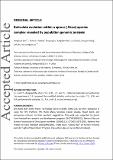Files in this item
Reticulate evolution within a spruce (Picea) species complex revealed by population genomic analysis
Item metadata
| dc.contributor.author | Sun, Yongshuai | |
| dc.contributor.author | Abbott, Richard J. | |
| dc.contributor.author | Lu, Zhiqiang | |
| dc.contributor.author | Mao, Kangshan | |
| dc.contributor.author | Zhang, Lei | |
| dc.contributor.author | Wang, Xiaojuan | |
| dc.contributor.author | Ru, Dafu | |
| dc.contributor.author | Liu, Jianquan | |
| dc.date.accessioned | 2019-10-25T23:36:21Z | |
| dc.date.available | 2019-10-25T23:36:21Z | |
| dc.date.issued | 2018-12 | |
| dc.identifier.citation | Sun , Y , Abbott , R J , Lu , Z , Mao , K , Zhang , L , Wang , X , Ru , D & Liu , J 2018 , ' Reticulate evolution within a spruce ( Picea ) species complex revealed by population genomic analysis ' , Evolution , vol. 72 , no. 12 , pp. 2669-2681 . https://doi.org/10.1111/evo.13624 | en |
| dc.identifier.issn | 0014-3820 | |
| dc.identifier.other | PURE: 256200300 | |
| dc.identifier.other | PURE UUID: 3dd0cecc-b807-4853-b0f3-1299730d7b2e | |
| dc.identifier.other | RIS: urn:3CA1EAF1F717F5F73FFB5FF659429AF7 | |
| dc.identifier.other | Scopus: 85055564398 | |
| dc.identifier.other | WOS: 000453088300007 | |
| dc.identifier.uri | https://hdl.handle.net/10023/18781 | |
| dc.description | This work was supported by grants from National key research and development program (2017YFC0505203), National Natural Science Foundation of China (grant numbers 31590821, 31670665, 91731301), National Key Project for Basic Research (2014CB954100), “1000 Youth Talents Plan” of Yunnan Province and CAS “Light of West China” Program. | en |
| dc.description.abstract | The role of reticulation in the rapid diversification of organisms is attracting greater attention in evolutionary biology. Evidence of genetic exchange between diverging taxa is reported frequently, although most studies fail to show how hybridization and introgression contribute to the adaptation and differentiation of introgressed taxa. Here, we report a population genomics approach to test the role of hybridization and introgression in the evolution of the Picea likiangensis species complex, which comprises four taxa occurring in the biodiversity hotspot of the Hengduan-Himalayan mountains. Based on 84,793 SNPs detected in transcriptomes of 82 trees collected from 35 localities, we identified 18 hybrids (including backcrosses) distributed within the range boundaries of the four taxa. Coalescent simulations, for each pair of taxa and for all taxa taken together, rejected several tree-like divergence models and supported instead a reticulate evolution model with secondary contacts occurring during Pleistocene glacial cycles after initial divergence in the late Pliocene. Significant gene flow occurred among some taxa after secondary contact according to an analysis based on modified ABBA-BABA statistics that accommodated a rapid diversification scenario. A novel finding was that introgression between certain taxa can contribute to increasing divergence (and possibly reproductive isolation) between those taxa and other taxa within a complex at some loci. These results illuminate the reticulate nature of evolution within the P. likiangensis complex and highlight the value of population genomic data in detecting the effects of introgression in the rapid diversification of related taxa. | |
| dc.format.extent | 13 | |
| dc.language.iso | eng | |
| dc.relation.ispartof | Evolution | en |
| dc.rights | Copyright 2018 The Author(s). Evolution Copyright 2018 The Society for the Study of Evolution. This work has been made available online in accordance with the publisher’s policies. This is the author created accepted version manuscript following peer review and as such may differ slightly from the final published version. The final published version of this work is available at https://doi.org/10.1111/evo.13624 | en |
| dc.subject | Coalescent analyses | en |
| dc.subject | Genetic divergence | en |
| dc.subject | Introgression | en |
| dc.subject | Picea | en |
| dc.subject | Population genomics | en |
| dc.subject | Reticulate evolution | en |
| dc.subject | QH301 Biology | en |
| dc.subject | DAS | en |
| dc.subject.lcc | QH301 | en |
| dc.title | Reticulate evolution within a spruce (Picea) species complex revealed by population genomic analysis | en |
| dc.type | Journal article | en |
| dc.description.version | Postprint | en |
| dc.contributor.institution | University of St Andrews. School of Biology | en |
| dc.identifier.doi | https://doi.org/10.1111/evo.13624 | |
| dc.description.status | Peer reviewed | en |
| dc.date.embargoedUntil | 2019-10-26 |
This item appears in the following Collection(s)
Items in the St Andrews Research Repository are protected by copyright, with all rights reserved, unless otherwise indicated.

